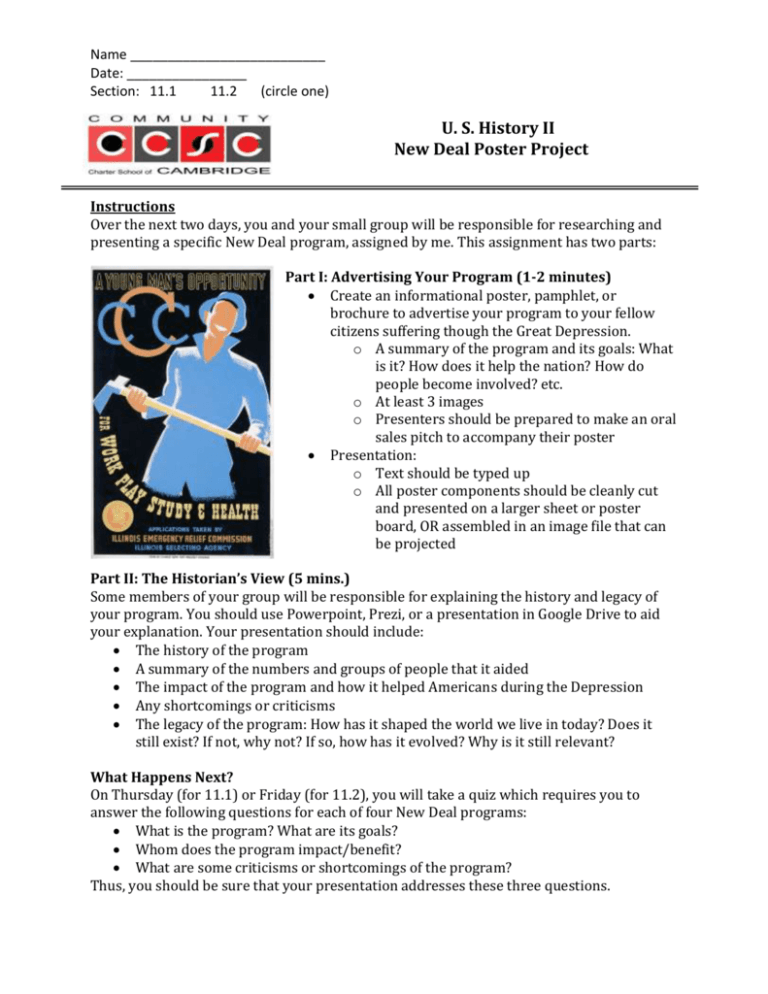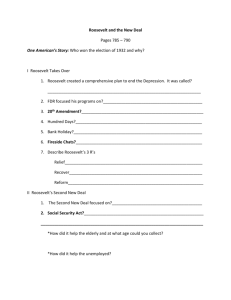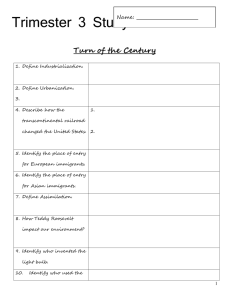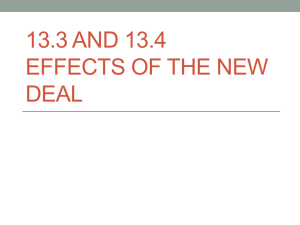
Name __________________________
Date: ________________
Section: 11.1
11.2
(circle one)
U. S. History II
New Deal Poster Project
Instructions
Over the next two days, you and your small group will be responsible for researching and
presenting a specific New Deal program, assigned by me. This assignment has two parts:
Part I: Advertising Your Program (1-2 minutes)
Create an informational poster, pamphlet, or
brochure to advertise your program to your fellow
citizens suffering though the Great Depression.
o A summary of the program and its goals: What
is it? How does it help the nation? How do
people become involved? etc.
o At least 3 images
o Presenters should be prepared to make an oral
sales pitch to accompany their poster
Presentation:
o Text should be typed up
o All poster components should be cleanly cut
and presented on a larger sheet or poster
board, OR assembled in an image file that can
be projected
Part II: The Historian’s View (5 mins.)
Some members of your group will be responsible for explaining the history and legacy of
your program. You should use Powerpoint, Prezi, or a presentation in Google Drive to aid
your explanation. Your presentation should include:
The history of the program
A summary of the numbers and groups of people that it aided
The impact of the program and how it helped Americans during the Depression
Any shortcomings or criticisms
The legacy of the program: How has it shaped the world we live in today? Does it
still exist? If not, why not? If so, how has it evolved? Why is it still relevant?
What Happens Next?
On Thursday (for 11.1) or Friday (for 11.2), you will take a quiz which requires you to
answer the following questions for each of four New Deal programs:
What is the program? What are its goals?
Whom does the program impact/benefit?
What are some criticisms or shortcomings of the program?
Thus, you should be sure that your presentation addresses these three questions.
Name __________________________
Date: ________________
Section: 11.1
11.2
(circle one)
The Programs
I will assign you to a small group researching one of the following New Deal programs:
Social Security Administration (SSA)
Works Progress Administration (WPA)
Civilian Conservation Corps (CCC)
Tennessee Valley Authority (TVA)
National Recovery Administration (NRA)
Federal Housing Administration (FHA)
Federal Deposit Insurance Corporation (FDIC)
Presentation Checklist
I recommend preparing for your presentation in the following order:
⧠ Use HW 6.7 to get a basic sense of what your assigned program was
⧠ With your group, find at least two sources online with more information about your
program
⧠ Complete HW 6.9 (attached)
⧠ With your group, decide who will make and present the poster, and who will
research and present the historian’s view
⧠ Create your poster and presentation
Rubric
Group
Content (x2)
Visuals
8
7
6
5
4
Presentation
displays
thorough and
detailed
understanding
of subject
matter
Visuals add
excitement and
interest
Presentation
displays
competent
knowledge of
subject matter
Presentation
displays some
gaps in
knowledge of
subject matter
Presentation
displays little
knowledge of
subject matter
Presentation is
completely
unrelated to
subject matter
Visuals
capture all
major points of
presentation
Appropriate
posture, tone,
and volume
Visuals capture
most major
points in
presentation
Posture, body
language, tone,
and/or volume
are sometimes
inappropriate
Visuals omit
major points
from the
presentation
Posture, body
language, tone,
and/or volume
interfere with
understanding
No visuals
Student asks
one relevant
question
Student
attentively
tracks all
presentations
and questions
Student is
occasionally
inattentive
during others’
presentations
Student is
disruptive or
visibly
disengaged
during others’
presentations
Individual
Presentation Posture, body
language, tone,
Skills
Audience
Participation
and volume
convey
authority and
engage the
audience
Student asks
one or more
insightful
questions
Presentation is
impossible to
understand
Name __________________________
Date: ________________
Section: 11.1
11.2
(circle one)
U. S. History II
HW 6.9: New Deal Program Summary
Instructions
In the space below or on a separate sheet of paper, respond to the following questions
about your assigned program. (Note: This is a group project, but you must do this
homework individually!)
Part 1: Program Summary
1. What is the name of your program?
2. In 1-2 sentences, give a basic definition of your program.
3. What group(s) of people did your program attempt to help? How?
4. How did your program help address the Great Depression?
5. What are some potential criticisms or shortcomings of your program?
Name __________________________
Date: ________________
Section: 11.1
11.2
(circle one)
Part 2: Group Progress
1. List 2-3 things your group has accomplished so far.
2. List 2-3 specific things your group needs to do tomorrow in order to do well on this
project. (“Research more” is not specific enough.)
3. List 1-2 things you individually need to do tomorrow in order for your group to do
well on this project.
4. List 1-2 questions (about your program, or about this assignment) that your group
needs to answer tomorrow in order to do well on this project.
Name __________________________
Date: ________________
Section: 11.1
11.2
(circle one)
New Deal Presentation Notes
Program: _____________________________________________________________
What is the program? What are its goals?
Questions:
Who did the program impact and benefit?
What were some criticisms/shortcomings
of the program?
Program: _____________________________________________________________
What is the program? What are its goals?
Questions:
Who did the program impact and benefit?
What were some criticisms/shortcomings
of the program?
Program: _____________________________________________________________
What is the program? What are its goals?
Questions:
Who did the program impact and benefit?
What were some criticisms/shortcomings
of the program?
Program: _____________________________________________________________
What is the program? What are its goals?
Questions:
Who did the program impact and benefit?
What were some criticisms/shortcomings
of the program?
Program: _____________________________________________________________
What is the program? What are its goals?
Questions:
Who did the program impact and benefit?
What were some criticisms/shortcomings
of the program?
Program: _____________________________________________________________
What is the program? What are its goals?
Questions:
Who did the program impact and benefit?
What were some criticisms/shortcomings
of the program?
Name __________________________
Date: ________________
Section: 11.1
11.2
(circle one)
U. S. History II
HW 6.10: Summing Up the New Deal
Part 1: Presentation Reflection
1. Describe one specific thing that your group did well. [1+ complete sentence]
2. Describe one specific thing that you did well. [1+ CS]
3. Describe one specific thing that your group could have done better. [1+ CS]
4. Describe one specific thing that you could have done better. [1+ CS]
5. Describe two specific things that you learned from other groups’ presentations. [2+
CS]
6. List one question that you still have about the New Deal after today’s presentations.
[1+ CS]
Part 2: The Legacy of the New Deal
Carefully read the following text (source: Emma Lapsansky-Werner et al., United States
History [Boston: Pearson Prentice Hall, 2008]). Use it, and your notes on New Deal
presentations, to do the following:
1. Complete the “New Deal” concept map and the definitions of New Deal programs in
your study guide.
2. On Thursday 3/27 (for 11.1) or Friday 3/28 (for 11.2), your class will have a silent
debate on the question, “Did the New Deal go too far?” Annotate this article for any
evidence you can find about the effects of the New Deal, good or bad. Have it ready
to use as a resource in our debate at the end of the week.
Effects of the New Deal on the American People
Women Help Lead the New Deal
The New Deal provided some women with the opportunity to increase their political
influence and to promote women’s rights. Foremost among them was Eleanor Roosevelt,
who transformed the office of First Lady from a largely ceremonial role to a position of
action and deep involvement in the political process. Representing the President, she
toured the nation. She visited farms and Indian reservations and traveled deep into a coal
mine. She helped FDR on his campaigns and offered advice on policy issues.
Mrs. Roosevelt’s causes included advancing public health and education, promoting
the arts in rural areas, and even addressing flood control. She exhibited boundless energy,
traveling more than 60,000 miles in two years.
The Roosevelt Administration included the first female Cabinet member, Secretary
of Labor Frances Perkins. She played a leading role in establishing Social Security. Perkins
also helped win approval of the Fair Labor Standards Act, which ended child labor and
established a minimum wage.
However, the New Deal did not fight to end gender discrimination in the workplace.
Indeed, some historians have argued that a number of New Deal programs reinforced
traditional gender differences. The WPA and other relief programs employed women but
made a much greater effort to provide work to men first. For example, women were not
eligible to work for the CCC. However, the increased homeownership and insured savings
accounts brought by the New Deal were of special benefit to the widows of men who were
covered.
African Americans Make Advances and Face Challenges
When the depression hit, African American workers were often the first to lose their
jobs. By 1934, the unemployment rate for African Americans was almost 50 percent, more
than twice the national average. Eleanor Roosevelt and others urged the President to
improve the situation of African Americans.
As the New Deal progressed, Eleanor Roosevelt increasingly used her position to
protest against racial discrimination. At a meeting held by the Southern Conference on
Human Welfare, a biracial group that sought to promote racial reforms, the first lady sat
with the black delegates—a daring move in segregated Birmingham, Alabama. When a
white police officer told her that she was violating local segregation laws, Mrs. Roosevelt
moved her chair to the space between the black and white sides. She then delivered a
rousing and provocative keynote address in favor of racial reform.
The President invited many African American leaders to advise him. These unofficial
advisers became known as the Black Cabinet. They included Robert Weaver and William
Hastie, Harvard University graduates who rose to high positions within the Department of
the Interior. Hastie later became a federal judge, and Weaver was the first African
American Cabinet member.
Mary McLeod Bethune was another member of the Black Cabinet. The founder of
what came to be known as Bethune Cookman College, she was a powerful champion of
racial equality. In her view, the New Deal had created a “new day” for African Americans.
She noted that African Americans gained unprecedented access to the White House and
positions within the government during Roosevelt’s presidency.
Nevertheless, Roosevelt did not always follow the advice of his Black Cabinet. Racial
discrimination and injustice continued to plague African Americans. When the NAACP
launched an energetic campaign in favor of a federal anti-lynching law, the President
refused to support it. FDR told black leaders that he could not support an anti-lynching law,
because if he did, southern Democrats “would block every bill I ask Congress to pass.”
Hence, no civil rights reforms became law during the 1930s.
Several New Deal measures also unintentionally hurt African Americans. Federal
payments to farmers to produce fewer crops led white landowners to evict unneeded black
sharecroppers from their farms. Even though they benefited from the WPA and other relief
measures, African Americans often did not receive equal wages. Social Security and the Fair
Labor Standards Act exempted domestic workers and farm laborers, two occupations in
which African Americans were employed in great numbers.
Effects of the New Deal on Government
The New Deal provided desperately needed relief from the depression and enacted
reforms that guarded against economic catastrophe. It did not end the depression. World
War II, with its massive military spending, would do that. Yet, the New Deal mattered
enormously because it brought fundamental changes to the nation. It changed the role of
the federal government in the economy, the power of the presidency, and the relationship
of the American people to their government.
The New Deal Creates a New Political Coalition
By the time he died in 1945, Roosevelt had been elected to four terms as President.
His legendary political skills had united an unlikely group of Americans into a strong
political force called the New Deal coalition. This coalition brought together southern
whites, northern blue-collar workers—especially those with immigrant roots—poor
Midwestern farmers, and African Americans.
African American voting patterns shows the importance of the New Deal coalition.
Before the New Deal, most African Americans voted Republican, the party of Abraham
Lincoln. Responding to the efforts of Franklin and Eleanor Roosevelt, African Americans
began to vote Democratic during the 1930s. This trend was strongest in the West and the
North. For example, in 1934, Arthur W. Mitchell, an African American democrat, defeated
Oscar De Priest, an African American Republican, to represent the largely black south side
of Chicago. Mitchell became the first African American Democrat elected to Congress.
The New Deal coalition gave the Democratic Party a sizable majority in both houses
of Congress. Before FDR’s election, the Democrats had been the minority party in the House
of Representatives for all but eight years since 1895. But from 1932 to 1995, the Democrats
controlled the majority of seats in the House of Representatives for all but 4 years. The
coalition that elected Roosevelt in 1932 went on to secure the White House for the
Democrats in six of the next eight presidential elections.
Besides forging a powerful political coalition, Roosevelt and the New Deal helped to
unify the nation. Social and ethnic divisions, so much a part of the 1920s, diminished
significantly during the 1930s. Immigrant communities, in particular, gained a greater
sense of belonging to the mainstream. Programs such as the CCC and WPA allowed
individuals of varied backgrounds to get to know one another, breaking down regional and
ethnic prejudices.
The Role of Government Expands
New Deal programs greatly increased the size and scope of the federal government.
“For the first time for many Americans,” writes historian William Leuchtenburg, “the
federal government became an institution that was directly experienced. More than the
state and local governments, it came to be the government.” Moreover, the government
began to do things it had never done before, from withdrawing taxes directly from
workers’ paychecks to distributing benefits to the elderly.
Though the New Deal did not end the depression, it did help restore the American
economy. It created the foundation for sustained and stable growth.
Playing a Larger Role in the Economy
With the New Deal, the federal government broke from the tradition of laissez faire
economics, or leaving the economy alone, which had characterized most of American
history. Now the federal government accepted responsibility for spurring economic
growth, or “pump priming”. For the first time, the government had acted as an employer of
the unemployed and a sponsor of work projects. FDR accepted the idea that the federal
government had to do something to get the economy going again, and Democrats and many
Republicans agreed.
FDR’s rejection of laissez-faire policies led a number of New Deal critics to accuse
him of promoting socialism. However, many New Deal measures actually strengthened
capitalism and helped make possible the economic boom of the post-World War II era. The
FDIC and SEC restored Americans’ trust in banks and the stock market. The Federal
Housing Authority (FHA) provided low-interest loans, increasing home ownership.
The New Deal affected millions of workers and their families. Minimum wage
increases improved the purchasing power of those at the bottom of the economic ladder.
New Deal legislation created child labor laws, workers’ compensation laws, and
unemployment insurance, programs that had important and enduring impacts on the US
economy.
By 1937, the economy had improved enough to convince many Americans that the
Depression was finally ending. Industrial production had returned to 1929 levels and
unemployment had fallen to 14%--still high, but much lower than in the early 1930s.
Roosevelt faced rising pressure from Congress to scale back on New Deal programs, and he
did. As a result, industrial production dropped again, and the number of unemployed rose
from about 7 million early in 1937 to 11 million early in 1938. Roosevelt did not like deficit
spending—spending more money than the government receives in revenues. Although the
New Deal did not end the Depression, it did help reduce the suffering of thousands of men,
women, and children by providing them with jobs, food, and money. It also gave people
hope and helped them to regain a sense of dignity.
The federal government had to go deeply into debt to provide jobs and aid to the
American people. The federal deficit increased to $3.3 billion in the fiscal year ending June
30, 1934. As a result of the cutbacks in federal spending made in 1937-1938, the deficit
dropped to $100 million. The next year it rose again to $2.9 billion. What really ended the
Depression was the massive amount of spending by the federal government for guns, tanks,
ships, airplanes, and all other equipment and supplies the country needed for the World
War II effort. During the war, the deficit reached a high of about $54 million, in 1943.
Creating a Welfare State
“We are going to make a country in which no one is left out,” Franklin Roosevelt
once told Frances Perkins. The many programs he enacted to realize this goal led to the rise
of a welfare state in the United States, a government that assumes responsibility for
providing for the welfare of children and the poor, elderly, sick, disabled, and unemployed.
The creation of the American welfare state was a major change in government
policy. With the exception of military veterans, most Americans had never received any
direct benefits from the federal government. State and local governments, private charities,
and families had long served as the safety net for needy Americans. True, the New Deal did
not achieve FDR’s goal of a “country in which no one is left out,” because it exempted many
Americans from Social Security and other programs. Still, the New Deal established the
principle that the federal government was responsible for the welfare of all Americans. In
the latter half of the twentieth century, the reach of government programs would grow
greatly.
New Deal reforms provided the framework for the debate over the proper role of
the federal government in the private lives of Americans. It energized liberals who would
push for an even greater role for the federal government in future years. But it troubled
conservatives who would argue that the expansion of the federal government limited
American rights. Indeed, this very debate divides liberals and conservatives to this day.
Changing the Nature of the Presidency
In no area did FDR have a greater impact than on the office of the President itself.
The expanding role of the government, including the creation of many new federal
agencies, gave the executive branch much more power. New Deal administrators, such as
Harry Hopkins, head of the WPA, commanded large bureaucracies with massive budgets
and little supervision by Congress. Their authority increased Roosevelt’s influence. Indeed,
some commentators even began to speak of the rise of an imperial presidency, an
unflattering comparison to the power exercised in the past by rulers of great empires.
FDR also affected the style of the presidency. His mastery of the radio captivated
Americans. His close relations with the press assured a generally popular response to his
project from the major media. Because he served for such a long time and was such an
outstanding communicator, FDR set a standard that future President had a hard time
fulfilling.
Later, during World War II, FDR’s presidential power grew even greater. As
commander in chief of the nation’s armed forces, he exercises enormous authority over
many aspects of life. Most Americans accepted the President’s increased authority as a
necessary condition of wartime. But after the war, they sought to protect the delicate
balance between the different branches of government and between the federal and state
governments.
One way that Americans sought to guard against the growing power of the President
was by amending the Constitution. When Roosevelt ran for an unprecedented third term in
1940, he knew that he had broken an unwritten rule, established by George Washington,
that Presidents should serve only two terms. But after Roosevelt’s death in 1945, there was
a growing call for limiting a President’s term in office. In 1951, the Twenty-second
Amendment was ratified, limiting the President to two consecutive terms.









